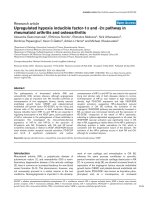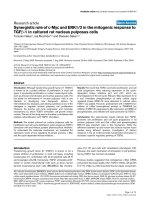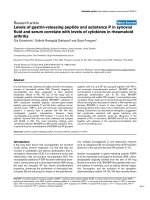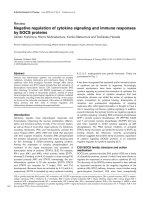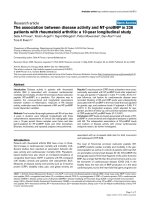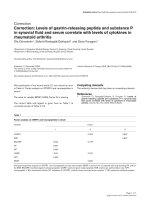Báo cáo y học: "Hyperosmotic stress enhances cytokine production and decreases phagocytosis in vitro" ppsx
Bạn đang xem bản rút gọn của tài liệu. Xem và tải ngay bản đầy đủ của tài liệu tại đây (641.51 KB, 8 trang )
Open Access
Available online />Page 1 of 8
(page number not for citation purposes)
Vol 12 No 4
Research
Hyperosmotic stress enhances cytokine production and decreases
phagocytosis in vitro
Natalie M Otto
1
, Ralf Schindler
1
, Andreas Lun
2
, Olaf Boenisch
1
, Ulrich Frei
1
and Michael Oppert
1
1
Department of Nephrology and Medical Intensive Care, Charité Universitätsmedizin Berlin, Humboldt University, Augustenburger Platz 1, 13353
Berlin, Germany
2
Institute of Clinical Chemistry, Charité Universitätsmedizin Berlin, Humboldt University, Augustenburger Platz 1, 13353 Berlin, Germany
Corresponding author: Michael Oppert,
Received: 6 Jun 2008 Revisions requested: 9 Jul 2008 Revisions received: 21 Jul 2008 Accepted: 18 Aug 2008 Published: 18 Aug 2008
Critical Care 2008, 12:R107 (doi:10.1186/cc6989)
This article is online at: />© 2008 Otto et al.; licensee BioMed Central Ltd.
This is an open access article distributed under the terms of the Creative Commons Attribution License ( />),
which permits unrestricted use, distribution, and reproduction in any medium, provided the original work is properly cited.
Abstract
Introduction Hyperglycemia is associated with negative
outcomes in various settings of critical illness; infectious
complications, especially, seem to be increased. On the other
hand, intensive insulin therapy (IIT) has been shown to improve
outcome in clinical trials. Whether normoglycemia itself or the
application of insulin is responsible for the observed findings is
unknown. We therefore tested the effect of glucose and insulin
on various immune functions in vitro.
Methods Human peripheral blood mononuclear cells (PBMCs)
were incubated ex vivo with low doses of lipopolysaccharide
(LPS). PBMCs were incubated with various osmotic agents,
insulin, or a combination of both. Interleukin (IL)-6 and IL-1
cytokine response was measured by enzyme-linked
immunosorbent assay. In addition, we investigated the effects of
glucose on phagocytosis and oxidative burst in human
granulocytes.
Results Increasing concentrations of both glucose and mannitol
significantly enhanced LPS-induced cytokine production. Insulin
alone did not alter cytokine production and had only a minor
influence in combination with glucose. Phagocytosis and
oxidative burst were significantly reduced with increasing
concentrations of glucose and mannitol.
Conclusion Hyperglycemia may lead to inflammation by
enhancing cytokine production via the direct effects of
hyperosmotic stress. Impaired phagocytosis and oxidative burst
under hyperglycemia may weaken defense mechanisms of the
host. Our in vitro findings may help to explain the beneficial
effects of IIT not only in diabetic but also in critically ill patients.
Introduction
Hyperglycemia is common in acutely ill patients and may be
attributed to the release of stress hormones, peripheral insulin
resistance, and certain drugs. Hyperglycemia is an independ-
ent risk factor for increased morbidity and mortality in critically
ill patients with a variety of conditions. After myocardial infarc-
tion, hyperglycemia is associated with an increased risk of in-
hospital mortality in patients with or without diabetes [1,2].
After cardiac surgery, hyperglycemia has been associated
with increased postoperative complications [3]. A randomized
and prospective trial among 1,548 surgical intensive care unit
(ICU) patients receiving mechanical ventilation demonstrated
that intensive insulin therapy (IIT) reduced mortality from
20.2% to 10.6% in patients who remained in the ICU for more
than 5 days [4]. These results were subsequently partially con-
firmed in patients admitted to a medical ICU [5].
The mechanisms underlying the detrimental effects of hyperg-
lycemia and the beneficial effects of IIT are not fully under-
stood but may be related to alterations in immune functions
and inflammation [6]. Hyperglycemia enhances plasma levels
of interleukin (IL)-6 and tumor necrosis factor-alpha (TNF-α) in
normal healthy volunteers [7,8]. Hyperglycemia after myocar-
dial infarction is associated with higher levels of C-reactive
protein (CRP) and IL-18 [9], and in the abovementioned study
[4] IIT decreased CRP levels significantly [10]. In a rabbit
model, strict glycemic control with insulin improved innate
immune function such as phagocytosis and prevented
CRP = C-reactive protein; ELISA = enzyme-linked immunosorbent assay; FITC = fluorescein isothiocyanate; FL1 = fluorescence-1; FSC = forward
scatter; ICU = intensive care unit; IIT = intensive insulin therapy; IL = interleukin; LPS = lipopolysaccharide; MAP = mitogen-activated protein; NF-κB
= nuclear factor-kappa-B; PBMC = peripheral blood mononuclear cell; PBS = phosphate-buffered saline; PMA = phorbol 12-myristate 13-acetate;
PMN = polymorphonuclear; ROS = reactive oxygen species; SSC = side scatter; TNF-α = tumor necrosis factor-alpha.
Critical Care Vol 12 No 4 Otto et al.
Page 2 of 8
(page number not for citation purposes)
excessive inflammation [11]. After endotoxin injection in pigs,
insulin treatment reduced the cytokine content of various
organs [12].
These in vivo studies indicate an important relationship
between hyperglycemia and immune cell function. However,
the precise cellular and molecular mechanisms of hyperglyc-
emia and insulin therapy have yet to be fully characterized. In
living animals, multiple interacting mechanisms are often diffi-
cult to separate. In particular, the protective effect of insulin
therapy may be due to insulin alone, the lowering of glucose,
its endocrine effects, or a combination thereof. To address this
question, we examined the effects of various hyperosmotic
substances (glucose and mannitol), as well as insulin, on
cytokine production in human peripheral blood mononuclear
cells (PBMCs) in vitro. In addition, we investigated the effects
of these hyperosmotic substances (glucose and mannitol) on
phagocytic and oxidative burst activity in human granulocytes.
Materials and methods
This study was approved by the Ethical Committee on Human
Research of Charité University Hospital (Berlin, Germany) and
was performed in accordance with the Declaration of Helsinki
(1964). Informed consent was obtained from all volunteers.
Preparation of peripheral blood mononuclear cells
Blood was taken from healthy volunteers (age range 24 to 46
years) without recent infectious or inflammatory conditions.
PBMCs were separated from whole blood by centrifugation
through Ficoll solution (Ficoll-Paque TM Plus; GE Healthcare,
Bio-Sciences AB, Uppsala, Sweden). PBMCs were washed
twice with normal saline, resuspended at 5 × 10
6
/mL in
serum-free culture medium (RPMI 1640; PAA Laboratories
GmbH, Pasching, Austria) containing glucose (100 mg/dL),
supplemented with
L-glutamine, penicillin, and streptomycin
(Biochrom AG Seromed, Berlin, Germany). PBMCs were pre-
incubated in 12-well plates (Nunc, Roskilde, Denmark) with
different concentrations of glucose (250, 500, and 1,000 mg/
dL), mannitol (500 and 1,000 mg/dL), or human insulin (10,
100, and 1,000 IU) for 3 hours at 37°C in a humidified atmos-
phere containing 5% CO
2
. After preincubation, cells were
stimulated with 0.5 ng/mL lipopolysaccharide (LPS)
(Escherichia coli 055:B5, Sigma-Aldrich number L6529;
Sigma-Aldrich, Munich, Germany) and subsequently incu-
bated for 24 hours. Samples were then stored at -80°C until
performance of the assay.
Cytokine assay
IL-6 and IL-1β levels were quantified by enzyme-linked immu-
nosorbent assay (ELISA) after two freeze-thaw cycles. Plates
(96-well; Maxisorp, Nunc) were coated overnight with the pri-
mary antibody (50 μL/well; R&D Systems, Wiesbaden-Nor-
denstadt, Germany) in a coating buffer (0.2 M NaHCO
3
/
Na
2
CO
3
, pH 10.5). Wells were then blocked with casein
(0.2%; Sigma-Aldrich) in phosphate-buffered saline (PBS) for
1 hour, after which sample and standard probes were added
to each well (50 μL/well) and incubated overnight. After three
to five washings, appropriately diluted biotinylated secondary
antibody (R&D Systems) was added to each well (50 μL/well)
and incubated for 1 hour. Plates were then incubated with per-
oxidase-streptavidin-biotin complexes (50 μL/well; Amersham,
now part of GE Healthcare, Braunschweig, Germany) for 1
hour and then developed with TMB (240 μg/mL 3,3',5,5'
tetramethylbenzidine; Fluka Chemicals, Buchs, Switzerland) in
Gallati buffer (42 μg/mL citric acid, pH 3.95/0.01% H
2
O
2
). All
dilutions were made in PBS containing 0.05% Tween (Sigma-
Aldrich), and wells were washed with PBS-Tween after each
incubation step. Cytokine levels in each sample were deter-
mined by measuring the optical density at 450 and 630 nm on
an ELISA plate reader (Dynastar MR5000, Dynatech, Chant-
illy, VA, USA). Samples were measured in duplicate in at least
two dilutions until values conformed to the linear part of the
standard curve. For IL-6, the sensitivity of the cytokine assay
varied between 5 and 10 pg/mL.
Phagocytosis assay
Phagocytosis was quantified by measuring the overall per-
centage of monocytes or granulocytes showing ingestion of
bacteria per cell and individual cellular phagocytic activity was
then analyzed. Heparinized whole-blood samples were incu-
bated with fluorescein isothiocyanate (FITC)-labeled E. coli
bacteria (1 × 10
5
bacteria per microliter of incubation medium)
at body temperature (37°C). As a control, one probe was left
on ice. Samples were then washed twice with PBS-Tween,
after which erythrocytes were lysed by adding prewarmed
lysis buffer. DNA staining solution was added prior to flow
cytometric analysis, excluding artifacts from bacteria or aggre-
gating cells. Granulocyte cell populations were gated using a
forward (FSC) and side (SSC) scatter to assess mean FITC
fluorescence activity. Granulocyte metabolism and production
of reactive oxygen species (ROS) led to morphological
changes that could be detected in the FSC and SSC. With the
CD14 surface marker, an additional assay of location and cell
population allocation was performed.
One sample was placed on ice and bathed in ice-cold quench-
ing solution prior to erythocyte lysis, in order to prevent active
phagocytosis. Fluorescence activity of this frozen probe pro-
vided a measure of the nonspecific binding of E. coli with the
granulocytes. Therefore, differential fluorescence activity of
the lysed population provided a quantification of active phago-
cytosis. Significant active phagocytosis was considered to
have occurred in samples in which mean fluorescence activity
of the heated probe exceeded 300% of the activity measured
in the inoculated probe left on ice [13].
Oxidative burst activity assay
Heparinized whole-blood samples were incubated with vari-
ous stimuli at 37°C. Unlabelled opsonized E. coli bacteria
were used as a particulate stimulus, the protein C ligand
Available online />Page 3 of 8
(page number not for citation purposes)
phorbol 12-myristate 13-acetate (PMA) was used as a high
stimulus, and the chemotactic peptide N-formyl-MetLeuPhe
(fMLP) subsequently was used as a low physiological stimu-
lus. Dihydrorhodamine 123 served as a fluorogenic substrate.
The negative control was a sample without stimulus. Whole-
blood samples were then lysed, washed, and stained to
exclude aggregation artifacts of bacteria or cells. The percent-
age of cells having produced reactive oxygen radicals was
then analyzed as well as their mean fluorescence intensity
(enzymatic activity).
Flow cytometric analysis
Cells were analyzed by flow cytometry using the blue-green
excitation light (488 nm argon-ion laser, BD FACScan with
CellQuest software; BD Biosciences, San Jose, CA, USA).
During data acquisition, a 'live' gate was set in the red fluores-
cence histogram on those events, which had at least the same
DNA content as a human diploid cell. Alternatively, bacteria
could be excluded by using the fluorescence triggering in the
FL2 or FL3 channel. Leukocytes (10,000 to 15,000 per sam-
ple) were collected. The percentage of cells having performed
phagocytosis (granulocytes and monocytes) was analyzed as
well as their mean fluorescent intensity (number of ingested
bacteria) and thus the percentage of cells having produced
reactive oxygen metabolites (recruitment) was analyzed as
well as their mean fluorescence intensity (amount of cleaved
substrate, activity). For that purpose, the relevant leukocyte
cluster was gated in the software (lin FSC versus lin SSC) and
its green fluorescence histogram (fluorescence-1, FL1) was
analyzed. The control sample was set as a marker for FL1 so
that fewer than 1% of the events were positive. The percent-
age of phagocytosing cells in the test sample was then deter-
mined by counting the number of events above the marker
position. The mean fluorescence correlates with the number of
bacteria per individual leukocyte for the phagocytosis and oxi-
dation quantity per individual leukocyte for the oxidative burst
activity assay. The test kit for the quantification of the oxidative
burst activity and the phagocytic activity of monocytes and
granulocytes in heparinized whole blood was obtained from
ORPEGEN Pharma (Heidelberg, Germany).
Statistical analysis
Values were tested for normal distribution (Shapiro-Wilk test
and D'Agostino and Pearson omnibus normality test) and were
expressed as mean ± standard error of the mean as indicated.
Groups were compared using repeated measures one-way
analysis of variance with post hoc testing by Bonferroni. A P
value of 0.05 or less was considered to be significant. Data
were analyzed using Prism 5 (GraphPad Software Inc., San
Diego, CA, USA).
Results
Effect of glucose on cytokine production
Exposure of PBMCs to hyperglycemic medium enhanced IL-
1β and IL-6 production in a concentration-dependent manner
when compared with no supplement addition (iso-osmolar)
medium. Figures 1a and 1c demonstrate that, under increas-
ing concentrations of glucose, the LPS-stimulated production
of IL-6 and IL-1β is significantly enhanced (P < 0.05). As little
as 250 mg/dL glucose led to a significant elevation of IL-6 lev-
els compared with no supplement addition (Figure 1a; P <
0.05). A dose-dependent effect could be demonstrated. The
production of IL-1β was significantly enhanced only at a sup-
plementation of 1,000 mg/dL glucose to the medium (Figure
1b; P < 0.05). Without LPS stimulation, increasing concentra-
tions of glucose (250, 500, and 1,000 mg/dL) did not cause
an increase in IL-1β and IL-6 cytokine release compared with
samples stimulated with LPS. For IL-1β, 0 mg/dL glucose =
7.7 pg/mL; 250 mg/dL glucose = 7.3 pg/mL; 500 mg/dL glu-
cose = 5.9 pg/mL; and 1,000 mg/dL glucose = 19.4 pg/mL.
For IL-6, 0 mg/dL glucose = 23.4 pg/mL; 250 mg/dL glucose
= 30.0 pg/mL; 500 mg/dL glucose = 53.1 pg/mL; and 1,000
pg/mL glucose = 53.2 pg/mL.
Effect of insulin on cytokine production
Insulin alone at increasing concentrations failed to alter the
LPS-stimulated IL-6 production (Figure 1b). Only in the case
of IL-1β, the highest insulin level (1,000 IU/mL) led to a small
but significant increase in cytokine production (Figure 1d).
Combination of glucose and insulin on cytokine release
To determine whether the hyperglycemic effect on cytokine
release seen in Figures 1a and 1c could be reversed by the
addition of insulin to the samples incubated with glucose, we
next tested the effect of a combination of glucose and insulin
on IL-6 and IL-1β cytokine production. The addition of insulin
to a high-glucose medium partially reversed the augmentation
of cytokine production mediated by glucose. The difference
was statistically significant only at the highest concentration of
both insulin (100 IU) and glucose (1,000 mg/dL) when meas-
uring IL-1β cytokine release (Figure 2d; P < 0.05).
Effect of hyperosmolarity on cytokine production
Using a different osmotic agent, we next investigated the influ-
ence of mannitol on cytokine production. PBMCs were prein-
cubated with glucose (1,000 mg/dL) or mannitol (1,000 mg/
dL). Figure 3 shows the IL-1β and IL-6 cytokine release over a
24-hour time period. The addition of 1,000 mg/dL glucose to
the medium led to a significant and prolonged increase in stim-
ulated cytokine production compared with no glucose (P <
0.05). The addition of mannitol (1,000 mg/dL) to the medium
also enhanced cytokine response; however, the augmentation
by mannitol was not as prominent compared with glucose and
did not reach statistical significance.
Effect of glucose and mannitol (hyperosmolarity) on
oxidative burst activity
We also examined the oxidative burst and phagocytic activity
in whole blood under the influence of hyperglycemic and
hyperosmotic conditions. The granulocytic oxidative burst
Critical Care Vol 12 No 4 Otto et al.
Page 4 of 8
(page number not for citation purposes)
activity using PMA (Figure 4a) or E. coli (Figure 4b) as stimuli
was significantly reduced under hyperglycemic conditions.
Adding the equal amount of mannitol (500 mg/dL) to the sam-
ples also led to a reduction of oxidative burst activity that was
significant when using PMA, but not E. coli, as stimulus (Figure
4).
Effect of glucose and mannitol (hyperosmolartiy) on
phagocytic activity
The addition of glucose (500 mg/dL) to the samples resulted
in a significantly reduced rate of phagocytosis in whole blood
compared with no supplement addition (Figure 5; P < 0.05).
Similar to the effect on oxidative burst activity, the addition of
mannitol (500 mg/dL) to the medium also led to a significant
decrease in phagocytic activity (Figure 5).
Discussion
Our results demonstrate that high concentrations of glucose
enhance LPS-induced cytokine production in fresh human
PBMCs. In addition, glucose decreases phagocytosis and oxi-
dative burst in whole blood. The effects of glucose appear to
be mediated by hyperosmotic stress since similar, though
weaker, effects could be observed using mannitol. Our find-
ings are in line with observations in animal models of critical ill-
ness [11,12]. In a porcine model, stress hyperglycemia led to
a significantly enhanced inflammation as shown by elevated
TNF-α and IL-6 levels [12]. This effect could be partly reversed
by the addition of insulin. Similarly, burn injury in rabbits [11]
leads to stress hyperglycemia and elevation of inflammatory
markers. The addition of insulin to maintain normoglycemia
resulted in reduced inflammation 3 days after the injury com-
pared with rabbits under hyperglycemia. Experimental hyperg-
lycemia was also shown to elevate circulating cytokine levels
in healthy volunteers as well as in diabetic subjects [7]. Inter-
estingly, diabetic patients had significantly higher cytokine lev-
els even before the glucose challenge leading to
hyperglycemia. After endotoxin stimulation, the induction of
hyperglycemia led to a slight but significant increase in IL-6 in
healthy volunteers, whereas TNF-α levels were unaffected [8].
The addition of insulin to reach normoglycemia, however, did
not alter the cytokine response in healthy volunteers. In criti-
cally ill surgical patients, however, IIT led to a reduced level of
Figure 1
Interleukin (IL)-6 (a, b) and IL-1β (c, d) cytokine release after lipopolysaccharide (LPS) stimulationInterleukin (IL)-6 (a, b) and IL-1β (c, d) cytokine release after lipopolysaccharide (LPS) stimulation. Samples were incubated with no supplement
addition, increasing concentrations of glucose (250, 500, and 1,000 mg/dL) (a, c), and increasing concentrations of insulin (10 and 100 IU) (b, d).
Stimulation occurred after a 3-hour preincubation with 0.5 ng/mL LPS. Cytokine release was measured by enzyme-linked immunosorbent assay after
another 24-hour incubation period (n = 11; mean ± standard error of the mean; *P < 0.05 versus no supplement addition).
Available online />Page 5 of 8
(page number not for citation purposes)
inflammation [4]. In this prospective randomized controlled
trial involving 1,548 adult patients, van den Berghe and
colleagues [4] demonstrated that IIT reduced mortality during
intensive care from 8.0% to 4.6%.
The greatest reduction in mortality involved deaths due to mul-
tiple-organ failure with a proven septic focus. IIT also reduced
overall in-hospital mortality, bloodstream infections, and acute
renal failure requiring renal replacement therapy. Although
cytokine levels were not measured, the level of inflammation as
expressed by the level of CRP was significantly lower in
patients under IIT compared with conventional insulin therapy
[4]. Furthermore, the rate of secondary infections and the rate
of severe sepsis decreased. The reason why critically ill
patients under IIT have fewer severe infections is not fully
understood. These results, however, indicate that functions of
the immune system may be altered.
Several experimental studies investigating the influence of glu-
cose, insulin, and osmotic stress on the immune system on a
cellular level have been undertaken [14-19]. Glucose was
shown to induce cytokine production in cell lines [14,20].
However, cell lines may react differently from freshly isolated
cells due to long and artificial culture conditions. Besides the
present study, only one group investigated fresh PBMCs and,
in agreement with our results, reported enhancement of IL-6
and TNF production by glucose [17]. Osmotic stress by hyper-
tonic saline in PBMCs led to conflicting results. Whereas Sha-
piro and Dinarello [18] found an elevation of cytokine levels,
others report of reduced cytokine production under osmotic
stress [15]. The present investigation confirms the results that
glucose is able to induce an enhanced cytokine response in
fresh human PBMCs. Although high concentrations of glu-
cose have been used in our study, it is important to consider
that only viable cells are able to produce and release
cytokines. Cytokines are not stored in intracellular compart-
ments but rather are newly synthesized and released in
response to inflammatory stimuli [21,22]. It is thus very unlikely
that the observed effects are due to nonspecific toxicity.
There are several potential explanations about the possible
underlying molecular mechanism of cytokine induction under
Figure 2
Interleukin (IL)-6 (a, b) and IL-1β (c, d) cytokine production after stimulation with 0.5 ng/mL lipopolysaccharideInterleukin (IL)-6 (a, b) and IL-1β (c, d) cytokine production after stimulation with 0.5 ng/mL lipopolysaccharide. Samples were preincubated for 3
hours with no supplement addition, 1,000 mg/dL glucose, or a combination of glucose (1,000 mg/dL) and insulin (10 and 100 IU). Cytokine concen-
trations were determined by enzyme-linked immunosorbent assay after a 24-hour incubation period (n = 11; mean ± standard error of the mean; *P
< 0.05 versus no supplement addition; **P < 0.05 versus 1,000 mg/dL glucose).
Critical Care Vol 12 No 4 Otto et al.
Page 6 of 8
(page number not for citation purposes)
increasing levels of glucose and changes in osmolarity. The
protein kinase C seems to be involved in the elevated cytokine
production by monocytes [14]. Furthermore, it has been sug-
gested that other mitogen-activated protein (MAP) kinases
and nuclear factor-kappa-B (NF-κB) are involved as well [23-
25]. Sherry and colleagues [25] could block LPS-induced
TNF-α production by inhibition of p38 MAP kinase in diabetic
mice. In another study, Németh and colleagues [26] observed
an increase in IL-8 production when exposing intestinal epithe-
lial cells to hyperosmotic conditions. This effect seemed to be
mediated by activation of p38 and p42/44 MAP kinase as well
as an increase in NF-κB [26]. In a sideline to the present study,
preliminary data of our group suggest the involvement of p38
MAP kinase.
In a clinical setting, the application of insulin seems to be
important as it lowers glucose levels and therefore improves
metabolic and osmotic homeostasis. A direct effect of insulin
on immune function, however, has not been demonstrated
before. In agreement, in the present study, we did not observe
that high doses of insulin alone alter the LPS-stimulated
cytokine response. The effects of insulin, even in combination
with glucose, were rather small and significant in only one
experiment. We therefore do not believe that insulin exerts
major direct effects on cytokine response.
During hyperglycemic conditions, such as inadequately con-
trolled diabetes, phagocytosis has been reported to be
impaired. Clinical trials showed a direct correlation between
metabolic control of diabetes and the phagocytic capacity of
polymorphonuclear (PMN) cells [27]. These findings are
supported by several animal studies: in one study, rabbits with
experimental diabetes were randomly assigned to receive
insulin treatment followed by a 30% burn injury. In the group
receiving insulin, phagocytic activity of monocytes improved
by 150%; similarly, a twofold augmentation of oxidative killing
compared with controls was observed [11].
In accordance with our findings, several previous studies sup-
port the notion that not only hyperglycemia but also changes
in osmolarity induce alterations in PMN cell function [19,27-
Figure 3
Interleukin (IL)-6 (a) and IL-1β (b) cytokine production over a time period of 24 hours after stimulation with 0.5 ng/mL lipopolysaccharideInterleukin (IL)-6 (a) and IL-1β (b) cytokine production over a time
period of 24 hours after stimulation with 0.5 ng/mL lipopolysaccharide.
Samples were preincubated for 3 hours under no supplement addition
and equal concentrations of glucose or mannitol (1,000 mg/dL). After
3, 6, 9, 12, and 24 hours of incubation, cytokine production was meas-
ured via enzyme-linked immunosorbent assay (n = 4 to 5; mean ±
standard error of the mean; *P < 0.05 versus no supplement addition).
Figure 4
Oxidative burst activity with phorbol 12-myristate 13-acetate (PMA) (a) and Escherichia coli (b) as stimuliOxidative burst activity with phorbol 12-myristate 13-acetate (PMA) (a)
and Escherichia coli (b) as stimuli. Samples were incubated for 3 hours
with no supplement addition, mannitol (500 mg/dL), and glucose (500
mg/dL). Oxidative burst activity was determined via flow cytometry (n =
10; mean ± standard error of the mean; *P < 0.05 versus no supple-
ment addition).
Available online />Page 7 of 8
(page number not for citation purposes)
29]. Impairment of phagocytic/oxidative burst activity under
increasing levels of glucose and changes in osmolarity may
have different explanations. Intracellular killing and phagocyto-
sis are partly transmitted via the formation of oxygen species
(ROS). Hyperglycemia was shown to inhibit ROS formation in
several studies [30]. Alexiewicz and colleagues [31] linked the
impaired phagocytic activity to elevated intracellular calcium
[Ca
2+
]
I
levels as they observed a significant direct relation
between [Ca
2+
]
I
and the degree of hyperglycemia. They also
suggested a glucose-induced calcium influx as well as an
increased activity of protein kinase C to be responsible for this
effect. They hypothesized that the acute increase in intracellu-
lar calcium would deplete the cell's adenosine triphosphate
content necessary for the conformational changes during
phagocytosis [18,32]. However, whether the observed in vitro
effects of hyperglycemia and hyperosmolarity can explain the
reported clinical benefits of IIT remains unknown. A study in
healthy human subjects undergoing a 4-hour hyperglycemic or
hyperinsulinemic euglycemic clamp test demonstrated no sig-
nificant changes in PMN cell function [33], indicating that a
short acute hyperglycemia may not be sufficient to provoke
changes in PMN cell function. Only a more complete under-
standing of innate immunity during alterations of the host's
physiologic milieu will enable the correlation of the observed
immunologic and metabolic alterations to the clinical outcome
of the patients. Many other aspects of innate immunity, such as
neutrophil apoptosis, chemotactic migration of monocytes and
neutrophils, complement-mediated cell lysis, the kininogen-
bradykinin system, or the role of the mast cell, still remain
poorly understood regarding their functional alterations during
acute hyperglycemia.
Conclusion
Clinical trials demonstrate considerable evidence for the ben-
efits of IIT in critically ill surgical patients. Our study focused on
the in vitro aspects of acute hyperglycemia, hyperinsulinema,
and hyperosmotic stress on the human innate immune system
in vitro. We could demonstrate that cytokine production by
fresh human PBMCs is enhanced under hyperglycemic and
hyperosmotic conditions. Furthermore, an impairment of neu-
trophil phagocytic and oxidative burst activity by glucose was
shown. Our in vitro findings may help to explain the beneficial
effects of IIT not only in diabetic but also in critically ill patients.
Competing interests
The authors declare that they have no competing interests.
Authors' contributions
NMO helped to plan the study, performed all experiments, and
helped to analyze the data and draft the manuscript. RS
helped to plan the study, supervised all experiments, and
helped to analyze the data and draft the manuscript. AL and
OB helped to plan the study, perform some experiments, ana-
lyze the data, and revise the manuscript for important intellec-
tual content. UF helped to plan the study, analyze the data, and
revise the manuscript for important intellectual content. MO
helped to plan the study, analyze the data, and draft the man-
uscript. All authors read and approved the final manuscript.
References
1. Capes SE, Hunt D, Malmberg K, Gerstein HC: Stress hypergly-
caemia and increased risk of death after myocardial infarction
in patients with and without diabetes: a systematic overview.
Lancet 2000, 355:773-778.
2. Marfella R, Siniscalchi M, Esposito K, Sellitto A, De Fanis U,
Romano C, Portoghese M, Siciliano S, Nappo F, Sasso FC,
Mininni N, Cacciapuoti F, Lucivero G, Giunta R, Verza M, Giugliano
D: Effects of stress hyperglycemia on acute myocardial infarc-
tion: role of inflammatory immune process in functional car-
diac outcome. Diabetes Care 2003, 26:3129-3135.
3. Vanhorebeek I, Ingels C, Berghe G Van den: Intensive insulin
therapy in high-risk cardiac surgery patients: evidence from
the Leuven randomized study. Semin Thorac Cardiovasc Surg
2006, 18:309-316.
4. Berghe G Van den, Wouters P, Weekers F, Verwaest C, Bruyn-
inckx F, Schetz M, Vlasselaers D, Ferdinande P, Lauwers P, Bouil-
lon R: Intensive insulin therapy in the critically ill patients. N
Engl J Med 2001, 345:1359-1367.
5. Berghe G Van den, Wilmer A, Hermans G, Meersseman W, Wout-
ers PJ, Milants I, Van Wijngaerden E, Bobbaers H, Bouillon R:
Intensive insulin therapy in the medical ICU. N Engl J Med
2006, 354:449-461.
Figure 5
Granulocytic phagocytic activityGranulocytic phagocytic activity. Samples were incubated for 3 hours
with no supplement addition, mannitol (500 mg/dL), and glucose (500
mg/dL) (n = 10; mean ± standard error of the mean; *P < 0.05 versus
no supplement addition).
Key messages
• Increasing glucose concentrations in vitro enhance
interleukin (IL)-6 and IL-1β cyotkine release by periph-
eral blood mononuclear cells (PBMCs).
• Addition of insulin alone has no effect on cytokine
release.
• Hyperosmolarity is also able, to a lesser extent, to
enhance cytokine release by PBMCs.
• Phagocytosis and oxidative burst are reduced under
increasing glucose and mannitol concentrations.
Critical Care Vol 12 No 4 Otto et al.
Page 8 of 8
(page number not for citation purposes)
6. Turina M, Fry DE, Polk HC Jr: Acute hyperglycemia and the
innate immune system: clinical, cellular, and molecular
aspects. Crit Care Med 2005, 33:1624-1633.
7. Esposito K, Nappo F, Marfella R, Giugliano G, Giugliano F, Ciotola
M, Quagliaro L, Ceriello A, Giugliano D: Inflammatory cytokine
concentrations are acutely increased by hyperglycemia in
humans: role of oxidative stress. Circulation 2002,
106:2067-2072.
8. Krogh-Madsen R, Moller K, Dela F, Kronborg G, Jauffred S, Peder-
sen BK: Effect of hyperglycemia and hyperinsulinemia on the
response of IL-6, TNF-alpha, and FFAs to low-dose endotox-
emia in humans. Am J Physiol Endocrinol Metab 2004,
286:E766-E772.
9. Marfella R, Esposito K, Giunta R, Coppola G, De Angelis L, Farzati
B, Paolisso G, Giugliano D: Circulating adhesion molecules in
humans: role of hyperglycemia and hyperinsulinemia. Circula-
tion 2000, 101:2247-2251.
10. Hansen TK, Thiel S, Wouters PJ, Christiansen JS, Berghe G Van
den: Intensive insulin therapy exerts antiinflammatory effects
in critically ill patients and counteracts the adverse effect of
low mannose-binding lectin levels. J Clin Endocrinol Metab
2003, 88:1082-1088.
11. Weekers F, Giulietti AP, Michalaki M, Coopmans W, Van Herck E,
Mathieu C, Berghe G Van den: Metabolic, endocrine, and
immune effects of stress hyperglycemia in a rabbit model of
prolonged critical illness. Endocrinology 2003, 144:5329-5338.
12. Brix-Christensen V, Gjedsted J, Andersen SK, Vestergaard C,
Nielsen J, Rix T, Nyboe R, Andersen NT, Larsson A, Schmitz O,
Tønnesen E: Inflammatory response during hyperglycemia and
hyperinsulinemia in a porcine endotoxemic model: the contri-
bution of essential organs. Acta Anaesthesiol Scand 2005,
49:991-998.
13. Lun A, Schmitt M, Renz H: Phagocytosis and oxidative burst:
reference values for flow cytometric assays independent of
age. Clin Chem 2000, 46:1836-1839.
14. Devaraj S, Venugopal SK, Singh U, Jialal I: Hyperglycemia
induces monocytic release of interleukin-6 via induction of
protein kinase c-{alpha} and -{beta}. Diabetes 2005, 54:85-91.
15. Hatanaka E, Shimomi FM, Curi R, Campa A: Sodium chloride
inhibits cytokine production by lipopolysaccharide-stimulated
human neutrophils and mononuclear cells.
Shock 2007,
27:32-35.
16. Igarashi M, Wakasaki H, Takahara N, Ishii H, Jiang ZY, Yamauchi
T, Kuboki K, Meier M, Rhodes CJ, King GL: Glucose or diabetes
activates p38 mitogen-activated protein kinase via different
pathways. J Clin Invest 1999, 103:185-195.
17. Morohoshi M, Fujisawa K, Uchimura I, Numano F: Glucose-
dependent interleukin 6 and tumor necrosis factor production
by human peripheral blood monocytes in vitro. Diabetes 1996,
45:954-959.
18. Shapiro L, Dinarello CA: Osmotic regulation of cytokine synthe-
sis in vitro. Proc Natl Acad Sci USA 1995, 92:12230-12234.
19. Zhang S, Yanaka A, Tauchi M, Suzuki H, Shibahara T, Matsui H,
Nakahara A, Tanaka N: Hyperosmotic stress enhances inter-
leukin-1beta expression in Helicobacter pylori-infected
murine gastric epithelial cells in vitro. J Gastroenterol Hepatol
2006, 21:759-766.
20. Shanmugam N, Reddy MA, Guha M, Natarajan R: High glucose-
induced expression of proinflammatory cytokine and chemok-
ine genes in monocytic cells. Diabetes 2003, 52:1256-1264.
21. Dinarello C: Interleukin-1 and interleukin-1 antagonism. Blood
1991, 77:1627-1652.
22. Blackwell T, Christman J: Sepsis and cytokines: current status.
Br J Anaesth 1996, 77:110-117.
23. Fiebich BL, Schleicher S, Butcher RD, Craig A, Lieb K: The neu-
ropeptide substance P activates p38 mitogen-activated pro-
tein kinase resulting in IL-6 expression independently from
NF-kappa B. J Immunol 2000, 165:5606-5611.
24. Sheikh-Hamad D, Gustin MC: MAP kinases and the adaptive
response to hypertonicity: functional preservation from yeast
to mammals. Am J Physiol Renal Physiol 2004,
287:F1102-F1110.
25. Sherry CL, O'Connor JC, Kramer JM, Freund GG: Augmented
lipopolysaccharide-induced TNF-alpha production by perito-
neal macrophages in type 2 diabetic mice is dependent on ele-
vated glucose and requires p38 MAPK. J Immunol 2007,
178:663-670.
26. Németh ZH, Deitch EA, Szabó C, Haskó G: Hyperosmotic stress
induces nuclear factor-kappaB activation and interleukin-8
production in human intestinal epithelial cells. Am J Pathol
2002, 161:987-996.
27. Marhoffer W, Stein M, Maeser E, Federlin K: Impairment of poly-
morphonuclear leukocyte function and metabolic control of
diabetes. Diabetes Care 1992, 15:256-260.
28. Cuschieri J, Gourlay D, Garcia I, Jelacic S, Maier RV: Hypertonic
preconditioning inhibits macrophage responsiveness to
endotoxin. J Immunol 2002, 168:1389-1396.
29. Gual P, Gonzalez T, Gremeaux T, Barres R, Le Marchand-Brustel
Y, Tanti JF: Hyperosmotic stress inhibits insulin receptor sub-
strate-1 function by distinct mechanisms in 3T3-L1 adipocytes.
J Biol Chem 2003, 278:26550-26557.
30. Dhindsa S, Tripathy D, Mohanty P, Ghanim H, Syed T, Aljada A,
Dandona P: Differential effects of glucose and alcohol on reac-
tive oxygen species generation and intranuclear nuclear fac-
tor-kappaB in mononuclear cells. Metabolism 2004,
53:330-334.
31. Alexiewicz JM, Kumar D, Smogorzewski M, Klin M, Massry SG:
Polymorphonuclear leukocytes in non-insulin-dependent dia-
betes mellitus: abnormalities in metabolism and function. Ann
Intern Med 1995, 123:919-924.
32. Fiebich BL, Akundi RS, Biber K, Hamke M, Schmidt C, Butcher
RD, van Calker D, Willmroth F: IL-6 expression induced by ade-
nosine A2b receptor stimulation in U373 MG cells depends on
p38 mitogen activated kinase and protein kinase C. Neuro-
chem Int 2005, 46:501-512.
33. Fejfarova V, Jirkovska A, Lupinkova J, Kovar J, Kalanin J, Striz I, Ski-
bova J, Boucek P, Pelikanova T: Effect of acute hyperglycemia
and/or hyperinsulinemia on polymorphonuclear functions in
healthy subjects. Metabolism 2006, 55:811-818.


